Matador Network's Blog, page 820
July 14, 2020
Trump international students order
Last week, US Immigration and Customs Enforcement and the Department of Homeland Security introduced new guidelines that would strip visas from international students who don’t take in-person classes. The controversial move would have effectively forced universities to offer in-person courses instead of keeping everything online, despite the warnings of many public health officials. Now, the policy has been rescinded after lawsuits brought by several universities and colleges, including Harvard and MIT.
Breaking: The government has agreed to rescind DHS and ICE rules barring international students attending online universities from staying in the U.S., per a hearing this afternoon in Harvard and MIT's lawsuit against the agencies.
— The Harvard Crimson (@thecrimson) July 14, 2020
Judge Allison Burroughs, a federal district judge in Boston who was expected to preside over the Harvard-MIT suit, said, “I have been informed by the parties that they have come to a resolution. They will return to the status quo.”
The Harvard-MIT lawsuit claimed that ICE’s new policy was designed to “force universities to reopen in-person classes,” increasing the risk of exposure to COVID-19. Universities also accused the administration of committing several other violations of a federal law called the Administrative Procedure Act, which determines the decision-making powers of federal agencies.
While international students will not get the college experience they have been looking for in the US, the rescinding of the order will still be welcome news. 
More like thisArt + ArchitectureThe 11 most beautiful college campuses in the US
The post Trump administration rescinds order stripping international students’ visas appeared first on Matador Network.

Third culture kids narrative

Established wisdom dictates that almost every owner of a British passport exhibits a near-frenzied appreciation for tea. Her Majesty Queen Elizabeth II starts each day with a pot of freshly brewed Earl Grey, after all. But as a third culture kid born to a Nigerian-British mother, I never truly felt British — until I realized how much I love tea.
The simplest definition of a third culture kid is someone who grows up in country A while their parents were born in country B and they now live in country C. For us, the world is a complex trifecta. We are at once from everywhere and nowhere, never enough for one place but handed a golden passport to survive anywhere: My childhood homes were in Namibia and Nigeria. My family left Nigeria when I was 12 and settled in the Netherlands. Although I had visited England as a child, I didn’t move there permanently until I was 18 when I left Holland to attend university in London.
While I am technically (and legally) British, I couldn’t partake in conversations about beloved TV shows like Only Fools and Horses, Blackadder or Monty Python’s Flying Circus to save my life. I am perfectly comfortable living without the traditional Sunday roast and deeply suspicious of Yorkshire pudding, which isn’t really a pudding at all, is it? I simply can’t relate to many of the typical facets of British daily life. Then, a few years ago, I moved to Panama and all that changed. One day, a friend identified one unmistakable Britishism of mine: I simply adore “a cuppa.”
In fact, such is the extent of my mania for this intoxicating drink that I always travel with 20 emergency teabags in my carry-on, and no heat wave is scorching enough to dissuade me from putting the kettle on. A warm brew is a perfect accompaniment to any meal as far as I’m concerned. I would not discriminate against tea with nachos or nasi goreng, a combination that some might view as blasphemous. The taste of tea itself is home, regardless of my geographic position.
Tea is undoubtedly Britain’s favorite drink. It is a cure-all for boredom or busyness, fever or fatigue. For an island nation of around 66 million people, we reportedly consume 165 million cups (or 20 Olympic swimming pools worth) of tea daily. An incriminating study by household appliances company Russell Hobbs even found that British office workers who refuse to make cups of tea for coworkers reduce their chances of getting a promotion.
That fateful day in Panama when my friend mentioned my obsessive tea-drinking, the penny dropped. I didn’t grow up in the UK, nor do I have the much-adored British accent. But at that moment, I realized I really am British.
For third culture kids, identity negotiation is often a disorienting dance. The longest I have lived anywhere is London, yet I have stronger emotional ties to the Netherlands because I moved right before adolescence. Heads are scratched when I use “we” when speaking of Nigerians, the Dutch, and the English. I show varying degrees of support for each team during the FIFA World Cup because membership to each group feeds me differently. Both my parents held Nigerian passports, yet I felt only partially accepted in Nigeria, where I was referred to as oyinbo, a delicately derogatory term for a Caucasian or non-culturally African person.
Researchers Oliver Picton and Sarah Urquhart explain the confusion that can crop up when one belongs to many different cultures perfectly in their recent study, Third Culture Kids and Experience of Places: “For third culture kids, mobility has the potential to both expand and simultaneously limit engagement and identification with place.” They also note that third culture kids articulate dislike of perceived nationalism and patriotism, which may partially explain the suppression of my English side. A singular nationality is impossible when your sense of place is constructed by multiple, often divergent, social contexts.
Home has always been a murky concept for me, and it’s even more muddled now that I travel and work remotely. Cultural intermingling naturally affects things like your sense of self, beliefs, and certainly your food preferences. I wouldn’t dream of having fries without mayonnaise as we do back home in the Netherlands. No one can tell me that raw herring doused with diced onions isn’t heaven, and I will forever love patatje oorlog, a common snack from my carefree days living in The Hague. This perplexing dish of potato chips, mayonnaise, satay sauce, and onions translates to “little war fries,” and it’s an unusual marriage of flavors — much like myself. Even this I would have alongside a cup of tea.
Drinking tea has been a springboard to explore (and embrace) my English side. I have since become aware of other very subtly British traits that I’ve been carrying around the world with me, such as excessive politeness, saying “cheeky” before mundane activities like eating out or napping, and demanding strong banter from all acquaintances. I may not outwardly look, sound, or act like a Brit, but you’ll always spot me with my milky mug. 
More like thisCoffee + TeaThe 5 major tea regions of Asia you need to know about
The post How I embraced my British-Nigerian identity through tea appeared first on Matador Network.

BIPOC family travel
While it’s true that traveling with young children changes the entire dynamic of a vacation, there are still so many reasons to travel with your family as a person of color. For example, how cool would it be for your children to play with kids who speak a language they have never heard before? Or taste food with new flavors, aromas, and ingredients for the very first time. The benefits are endless, but here are just a few of the reasons why you should travel with your children as a person of color.
1. Travel offers the chance to see the world from a different perspective.

Photo: LightField Studios/Shutterstock
One of the greatest gifts of travel is the opportunity to see the world from a different perspective. Walking tours, museum visits, and homestays provide insight into a place’s history, cultural traditions, and its people — all things that come to life when you take the time to travel. These kinds of experiences can be especially important to children of color because it exposes them to a different type of education that they will not get in the classroom.
With this gained perspective might also come a newfound feeling of gratitude. Being exposed to a community that has more or less than what your children have will hopefully teach them empathy for others’ experiences and encourages them to be thankful for what they have at home.
A great alternative to a traditional vacation is to volunteer abroad or experience a homestay. When I volunteered to teach English in Costa Rica, I was exposed to a side of that culture that I would not have had the opportunity to know if I was an average traveler. By staying with a host family, I was able to practice my Spanish every day and made lifelong friends with other volunteers from around the world.
2. Prove that children of color deserve the same experiences.

Photo: DisobeyArt/Shutterstock
As both domestic and international travel become more common, we notice that families of color are absent from popular hashtags such as #familytravel or #familytravelblog. People may look at those hashtags and assume that families or children of color do not travel at all, but that is not the case. There is a whole movement of Black and Brown people traveling, and recent studies show that they spend billions of dollars on travel each year. With that said, another great reason to travel with your children is to show them (and the world) that they deserve the experience of travel as much as anyone.
Travel can be such an inspiring and enriching gift, and if possible, this gift should be made available to everyone. Exposure to travel could be seen as an equity issue, but that does not have to be the case. Children of color are traveling, and hopefully, even more will start to travel soon. We just have to do a better job of showing them that it’s possible and already happening.
3. Learning doesn’t only happen in the classroom.

Photo: Iakov Filimonov/Shutterstock
Travel can be a precious tool through which we can teach our children things that cannot be taught just in school. For example, imagine reading about Antoni Gaudí’s La Sagrada Familia cathedral or Pablo Picasso’s “Guernica” painting in a textbook compared to seeing both of these incredible masterpieces in person. The opportunity to learn about works of art like these and watch history come to life only happens through travel and witnessing things like these in person. Not to mention, moments like this also allow us to foster our children’s interests in art, architecture, and more.
As parents, we want to give our kids the best of everything. And one way to do that is by sharing new cultures, traditions, religions, languages, politics, etc. outside of the classroom and in interactive ways.
4. Travel inspires new possibilities

Photo: Merla/Shutterstock
There are so many professions that allow or require a person to travel, including diplomats, ambassadors, and even school teachers. But what would first spark even an interest in these career paths without exposure to new lands? Traveling at a young age could influence children of color to want to live abroad and seek out potential careers and educational paths that afford them that opportunity.
When we shelter our children from the world, they grow to fear the unknown and believe that there is only one way to live. We should teach our children about the celebrated novelist and playwright James Baldwin and actress and war hero Josephine Baker — two notable African Americans who made France their home — and inspire them to dream big.
5. Travel creates lasting memories.

Photo: eggeegg/Shutterstock
For better or worse, travel allows us to unplug from social media, email, and other distractions and encourages reconnecting with our travel companions, even if those companions are children. And even if your kids are too young to remember where you went or what you saw, they will remember the feelings that they felt when they spent quality time with their parents, grandparents, or other family members.
The topics mentioned above are just a few compelling reasons why you should travel with your children as a person of color. From challenging perspectives to new teaching methods, and even the ability to create memories, travel can be invaluable. 
More like thisOutdoorSummer camps for BIPOC children are diversifying the outdoor experience
The post Why you should travel with your children as a person of color appeared first on Matador Network.

Most bizarre weather phenomena
Our planet is an ever-changing place. Over time, entire ecological zones evaporate, continents move, oceans disappear, mountains erode. On the day-to-day, it seems like we can’t see these processes at work — but in a way, we can, by watching the weather do its thing.
Beyond rain, snow, hail, and wind, Earth is up to some pretty incredible — and some incredibly bizarre — work. Take a look, and then go find these wild phenomenons for yourself.
1. Dust devils
Photo: JordiStock/Shutterstock
When the ground is practically boiling hot, cooler air gets pushed up. Throw in some high winds, and you’ve got “dust devils,” little dust vortexes whirling from the ground up. They usually only last a few minutes, and they can range from a few feet tall to a few hundred. They’ll whip up whatever’s on the ground — usually dust, dirt, and weeds. Note: This can happen with fire, too. Then it’s called “fire whirls.”
Where to spot them: Anywhere that’s arid and dry. Think Nevada, Texas, or Kenya.
2. The green flash
Photo: Yrii Kurygin/Shutterstock
Light from the sun can do a lot of wild things, one of which is flash green — but just for an instant. And in this scenario, approximately two seconds.
It happens just as the sun is barely above (or below) the horizon — this is when the light is most refracted. Water vapor easily absorbs yellow and orange, and air molecules scatter violet light, leaving your eyes to take in blues and greens. The top rim of the sun doesn’t actually flash green — it’s an optical illusion.
Where to spot it: Anywhere on a clear day with a distant horizon, though west-facing beaches in Florida or Hawaii are a great bet for sunset.
3. Catatumbo lightning
Photo: christianpinillo/Shutterstock
Named after the phenomenon that strikes above the spot where the Catatumbo River empties into Lake Maracaibo, Catatumbo lightning is the result of a perfect setup: the lake, the river, the adjacent plains that collect heat and moisture, and methane gas rising from nearby bogs. It strikes most nights of the year for up to 10 hours at a time and regularly up to 280 times per hour. This world-famous lightning storm is so reliable (and visible from 250 miles away!) that it’s even been used for navigation.
Where to spot it: Only in Venezuela, at the mouth of the Catatumbo River. It’s known as the “most electric place on Earth.”
4. Ice caves
Photo: nikitsin.smugmug.com/Shutterstock
Take a gigantic lake, sea, or bay, carve out some sea caves on the coast, and then freeze everything, and you’ve got a chance at ice caves. Before everything freezes over, water laps, seeps, and drips from all surfaces, and if conditions are perfect enough, ice takes over the rocks on all sides. A blip of slightly warmer weather or strong winds can undo the ice, though, making these a fragile phenomenon despite any routinely harsh winter.
Where to find them: A known spot is Apostle Islands National Lakeshore in Wisconsin. It’s a two-mile hike in the dead of winter, though, so know what you’re in for.
5. Sundogs

Photo: Plum Creek Aerial/Shutterstock
In January 2019 — when the polar vortex hit — you could see sundogs all across the Midwest and Northeast of the United States. Milwaukee, for example, hit -21 degrees Fahrenheit (-40 degrees with wind chill), a new record.
When it’s this cold, the sun is near the horizon, and cirrus clouds string through the sky, particles of sunlight get deflected by ice crystals, and a lit halo forms around the sun. When conditions are perfect, “mini suns” will flank the actual sun on either side, forming sundogs.
Where to spot them: Anywhere that’s ridiculously cold.
6. Lenticular clouds

Photo: Michael Dorogovich/Shutterstock
Nope, not a UFO. Lenticular clouds form on the downwind side of a mountain when moist air flows downward, drops below the dew point, and stabilizes — lenticular clouds don’t move. They can appear as one or stacked in a series, and though they seem calm, they’re known for producing turbulence. Pilots, avoid these.
Where to spot them: Near mountains, particularly on the downwind side.
7. Snow donuts

Photo: Maria Moroz/Shutterstock
If there’s a layer of particularly wet snow on top of ice (or drier, powdery, colder snow) and enough wind, you may find yourself in a field of snow donuts. All it takes in these conditions is for a bit of snow to start rolling — and rolling and rolling — until eventually it stops and, at some point, the middle collapses. Voila, a snowball with no center: a snow donut.
Where to spot them: It sounds fairly simple, but snow donuts are a pretty rare phenomenon. They’ve been documented in Washington and the Midwest in the United States, and a few times in Northwestern Europe.
8. Waterspouts

Photo: Rob Atherton/Shutterstock
This is, essentially, a tornado that forms over water. These H2O vortexes bring with them high winds, hail, and lightning, but they are usually a bit weaker than their land-based counterparts — though they can still destroy boats and coral reefs. They usually dissipate before hitting solid ground.
Where to spot them: Anywhere there’s open water, though the Florida Keys are a notable spot.
9. White rainbows
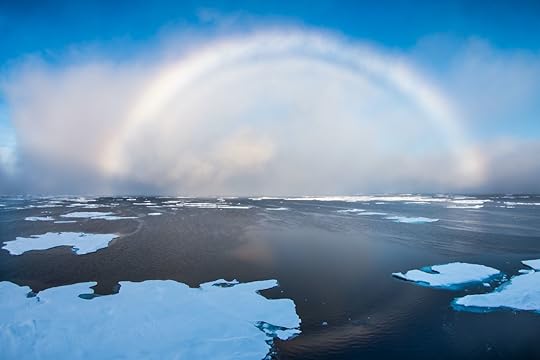
Photo: Mikhail Varentsov/Shutterstock
Technically, “white rainbows” are fogbows, forming in fog instead of rain. Fog is made of particularly tiny droplets, making for weaker colors as the sunlight passes through. When conditions are right, a foggy “rainbow” appears opposite the sun, just like a rainbow.
Where to spot them: Somewhere foggy — San Francisco, for example. 
More like thisNewsThis map shows how to stay in perfect weather all year
The post 9 bizarre weather phenomena and where to see them appeared first on Matador Network.

What to pack for extreme backcountry
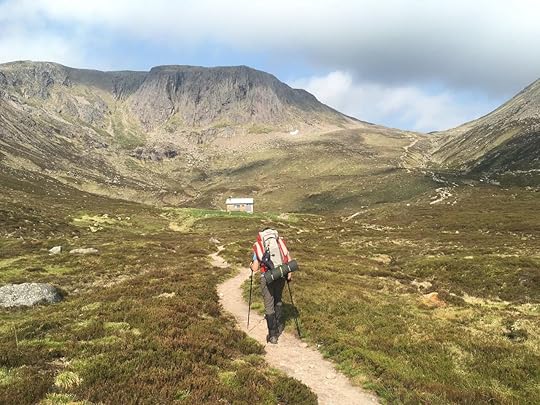
Before any proper trip can start, you have to pack a bag. In the Essential Packing series, Matador speaks with experts for insight on what they take with them on their adventures.
“Nothing bad can happen to a writer as long as you get home to write the book.”
So are the words of UK writer and adventurer Dan Richards, author of Outpost: A Journey to the Wild Ends of the Earth. The book is a collection of tales of adventure in the rawest sense, and it offers little clarity on whether this statement is fully ominous or merely a line of encouragement that Richards holds onto when secluded in far-flung locales around the globe.
Outpost chronicles the places championed by those who prefer remote isolation in the depths of the wilderness, whether for work, recreation, or necessity. Richards treks to the bothies of Scotland, the Mars Desert Research Station in Utah, and other hard-to-reach lodging from Iceland to Svalbard.
The impetus for the book was a polar bear pelvis kept in the closet of Richards’ father, a remnant of a trip he had taken to the Icelandic outback. Richards wanted, in a sense, to follow the passions of his father and highlight the places where people like him found themselves most decompressed. Outpost is a tale of finding deeper meaning as much as it is a tale of adventure.
But we’re not here to talk about the book. Read it. If you’re the type that succumbs to frequent bouts of trekking, nomading, or wanderlusting, you’ll be better for the effort. Though fair warning: It’s impossible to read Outpost without then wanting to immediately set off on an expedition into the natural unknown.
Which draws the question of what to take and what to leave behind. For avid and aspiring backpackers, a number of actionable takeaways jump out from Richards’ trip planning process, including how to stay dry when you find yourself deluged in the elements of the high alpine. Matador Network spoke with Richards about his travel setup — namely his pack, what he puts inside of it, and how his gear setup has evolved since he first began following in his father’s footsteps.
The absolute essentials
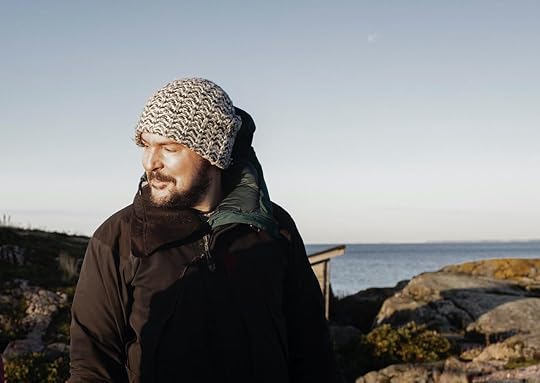
Photo: Ian Winstanley, provided by Dan Richards
No trek is possible without a good pair of boots. Richards is a fan of the Hanwag Tashi boot, made of actual yak leather. “I did some research and found that yaks don’t really sweat,” Richards says. “When they get too hot, they move up the mountain, and when they get too cold, they move back down the mountain.”
A life of dealing with the elements makes yak leather stronger than cow leather. This was perfect, Richards thought. At more than $350, the Tashi boot is certainly not for the budget traveler. Looking at a photo of Richards, he doesn’t strike as the Hugo Boss type — writers reporting from literal treehouses rarely are — but it would be right to assume that part of his expeditions’ success stems from being properly outfitted. There’s no reason to make a backcountry excursion more rugged than it needs to be by skimping on gear.
And, just as important, the pack that holds all that gear.
“I’ve always mainly used a hand-me-down kit until very recently,” Richards says. “My dad, for his expeditions, had this brilliant Hasten sack, which is like a Carrymore backpack, one of the first backpacks designed by climbers and explorers.”
These were the earliest form of climbing packs in the 1970s, giving mountain climbers a pack designed specifically for their needs rather than a basic army kit. Richards used this pack in the book’s Cairngorms chapter, but then it broke, as happens with decades of heavy use.
Richards then strapped a Klättermusen pack, having become a fan of its products because it is “the best sustainable, responsibly made, top-end gear I’ve found.”
Inside, Richards packs many incarnations of wool. “Wool will keep you warm even when you’re wet, and I’m often quite deluged,” he says. He breaks down his wearables and other packed items as follows:
Socks, gloves, and other base layers: Richards likes layers of wool as they’re easy to take off and put back on as needed, as compared to heavier material. Wool socks, long johns, and gloves are in his pack as well. In particular, he’s a fan of Huber Dachstein felted wool gloves.
Sleeping bag: A feather-stuffed sleeping bag, either four-season or two-season, in a double-layer of refuse sacks to keep it dry.
Tent: “If I’m taking a tent, it will probably be a one-man tent that is as small and as durable as possible,” Richards says. “I can sleep on most things. I won’t have a groundsheet.”
Shoes: In addition to boots, Richards prefers a pair of light deck shoes like Converse because ”you don’t want to wear your heavy boots all the time.”
Extra clothing: “It’s always good to have a clean shirt and a decent pair of trousers if you need to be presentable for whatever reason,” Richards says. “So within my pack there would be another bag with one outfit that contains these in case I need to pitch up back in civilization.”
Richards also keeps an additional bag in his pack with matches, kindling, a penknife, and a water filter.
Things you wouldn’t think you’d need
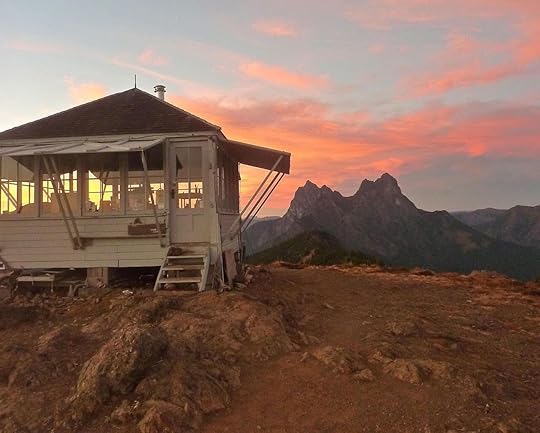
Photo: Jim Henterly, provided by Dan Richards
Beyond the mandatory gear, Richards packs a number of small provisions helpful for when the going gets rough. For example, he carried hard cheese, nuts, raisins, cured sausages, and Coca-Cola with him for a week in Washington’s North Cascades. Trail food is a staple of his diet between the bookends of trips when he’s more likely to be in a city with proper dining options.
He also became quite fond of:
Extra boot laces: These can also act as guy ropes for your tent on particularly windy nights, Richards notes.
Knife
Extras: Tin foil, gaffer tape, and a mug.
Pillowcase: Richards notes this as a particularly useful hack because, “you can stuff it with dirty clothes and then you don’t have to bring pillows.”
Printed copies of all trip needs: “I’ve been in too many positions where it’s so cold that your phone stops working, things like that,” Richards says. “I think analog is the way to go.”
Tips and tricks of the trade
First and foremost before heading into the wilderness, Richards says, is to make sure the gear and tools you have with you are repairable. “I’m a big believer that if you have any kit with you, it should be repairable,” he says. “So many people bring this stuff and then it breaks, and that’s the end of that.”
This is when the knife, gaffer tape, and other small menders come in handy.
To keep productive on the go, Richards uses layovers and travel days to email, write, and maintain general correspondence with the world.
“Airport time is really when I get my office stuff done on the move,” Richards says.
And he brings books.
“I read a lot when I’m away, and I make a lot of notes,” Richards says. Though he brings a laptop on most excursions, he also carries paper notebooks because, “you can’t rely on digital things.”
Outpost: A Journey to the Wild Ends of the Earth is available at bookstores and online from Canongate. Follow Richards on Twitter and via his Canongate author page. 
More like thisCampingThe ultimate guide to everywhere you can camp permit-free on US public lands
The post How an adventure writer packs for extreme backcountry hiking appeared first on Matador Network.

Jamaica travel guide summer 2020
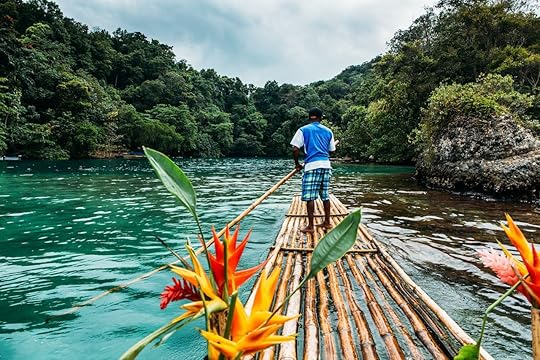
Jamaica was a dream destination long before COVID-19 hung all hopes of summer travel on the Caribbean. Visitors are drawn to the island’s reputed rhythm, which builds with every lapping wave and swaying banana palm, every shot of rum and espresso, and every patois word, then crescendos in Jamaica’s packed, sweaty dance halls.
Clubs may be out of the question this summer, but Jamaica can still be the island escape travelers need, now more than ever. Even Americans are invited. Although temporary travel requirements pose challenges for quick trips, Jamaica has opened up its most coveted coastline for the summer 2020 holiday. Here’s everything you need to know to enjoy it.
Before you go and getting there
COVID-19 safety measures on the island
Where to stay in the Resilient Corridor
How to enjoy the Jamaican outdoors while social distancing
Before you go and getting there
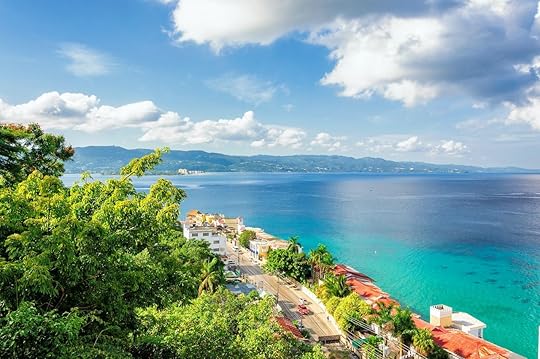
Photo: Lucky-photographer/Shutterstock
Jamaica began reopening to international travelers last month, designating a “coronavirus-resilient” tourist zone on the north coast from Negril to Port Antonio. All travelers are required to apply for a travel authorization within 72 hours of their trip and will be asked to present their authorization at the airport prior to boarding. Travelers from high-risk areas are required to submit a negative COVID-19 test taken within 10 days of their departure date. From July 15, this includes US tourists from Florida, New York, Arizona, and Texas.
Air travelers will also be screened upon arrival. All passengers will be interviewed and have their health assessed at the airport. Those deemed high-risk may be asked to take a COVID-19 test, after which they’ll be required to quarantine at their accommodation pending the results. Travelers who test positive will be put in isolation at their hotel or a designated facility.
COVID-19 safety measures on the island
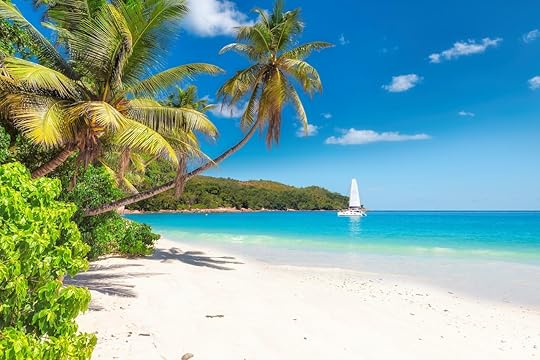
Photo: Lucky-photographer/Shutterstock
Tourists are restricted to the Resilient Corridor for the duration of their stay, per the current Stay in Zone order. Tourism operators in this zone must receive COVID-19 resiliency certificates before they’re permitted to open. Among the protocols outlined in the 120-page document shared by the Jamaica Tourist Board are health and hygiene mandates for accommodations like resorts and Airbnbs; transportation; beaches; and social activities.
Visitors are expected to do their part, as well. Travelers are required to practice social distancing and wear face masks in communal areas. Other safety precautions may be in place, as well, such as venues or transportation operating at limited capacity, or restaurants in town serving only takeout. Until July 31, there’s also an island-wide curfew from 11:00 PM to 5:00 AM.
Where to stay in the Resilient Corridor

Photo: photopixel/Shutterstock
Although Jamaica is not entirely open to travelers, the resorts that travelers overwhelmingly favored pre-pandemic are in the Resilient Corridor.
Montego Bay is Jamaica’s all-inclusive capital. Hyatt, Hilton, Holiday Inn, and other big names have claimed the blindingly white shoreline, carving out oceanfront real estate for resort guests. Sandals Montego Bay’s private beach is said to be one of the finest stretches.
Another of the island’s most popular towns, Ocho Rios, sits smack in the center of the northern coast. A big port for cruisers, it also has a rugged side. If the normally lively dining and nightlife scenes are operating at limited capacity or stunted by safety precautions, travelers can keep busy with zip lines and hikes to the Dunn’s River, Konoko, and Island Guy Falls instead.
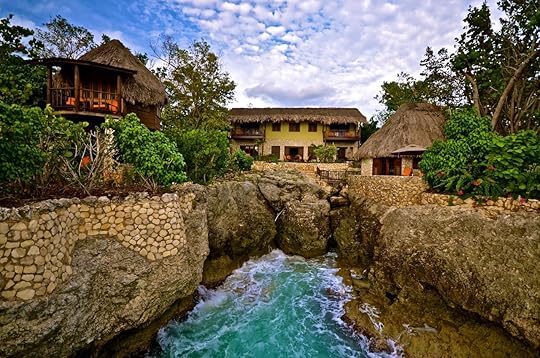
Photo: clark smith/Shutterstock
In Negril, the western border of the tourist zone, adventure travelers can keep a safe social distance with activities like horseback riding, ATV riding, scuba diving, cliff jumping, and relaxing at Seven Mile Beach, which has been called Jamaica’s most beautiful. Everyone’s welcome: A former hippy colony, Negril now houses all-inclusives, luxury boutique hotels, and a range of affordable stays.
Port Antonio marks the eastern border of the tourist zone, yet it feels worlds away from the resortland to the west. The speed here is set by Blue Mountains hikes and bamboo rafting excursions down the Rio Grande. A couple of pricey hotels remind visitors of Port Antonio’s past as a 1940s A-lister getaway, but most stays now are modest and affordable.
Though the Resilient Corridor is funneling travelers very much onto the beaten path, there are some 150 miles between Negril and Port Antonio, with smaller towns like Falmouth and Runaway Bay breaking up the big resorts. That’s a fair trade for a travel zone that helps make COVID-19 easier to manage and trace for everyone’s safety.
How to enjoy the Jamaican outdoors while social distancing
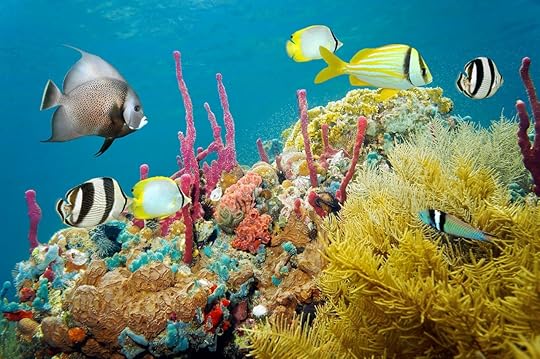
Photo: Damsea/Shutterstock
With indoor activities limited, Jamaica’s outdoor adventure is more important than ever. Even fresh air sans excitement is key: Sunbathing can be socially distanced, after all.
When they’re not splayed out in the sand, travelers have their pick of beachy fun. Snorkeling is possible almost everywhere. Negril and Montego Bay are known to have reliably vibrant off-beach reefs, with Montego Bay sites like Marley’s Garden and Coyaba Reef snagging the advantage for snorkelers. Runaway Bay, located roughly 10 miles west of Ocho Rios, also opens to some excellent snorkeling, including at the Runaway Bay Wall.
Where Negril gets the advantage is scuba sites, from the 40-foot-deep Throne Room with its swim-through caves to the drift at The Arches, a max 70-foot dive site featuring the wreck of an intentionally sunken plane. Montego Bay and Ocho Rios have roughly a dozen dive sites of their own, while Port Antonio’s Alligator Reef is broken up into five sites of varying difficulty.
Falmouth, located midway between Montego and Runaway Bay, offers a different aquatic draw: the Luminous Lagoon. Here, travelers can take in the best of Jamaica’s bioluminescence with a nightly glow-in-the-dark lights show. Falmouth visitors can also try rafting on the Martha Brae River, much as they can on the Rio Grande in the Portland Parish.
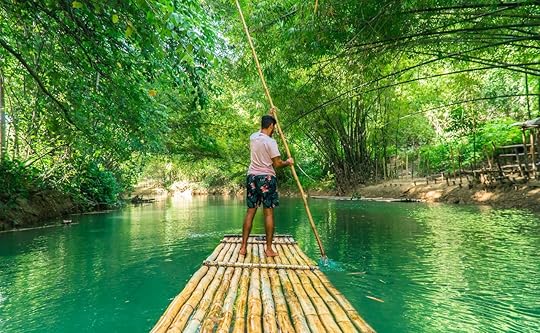
Photo: Jam Travels/Shutterstock
Under normal circumstances, the 180-foot-tall, 600-foot-long Dunn’s River Falls outside of Ocho Rios is reason enough to visit Jamaica. The rare travertine waterfall network is one of the most-visited attractions in the entire Caribbean, offering both wet and dry climbs. Yet with great popularity comes great crowds. This particular trip, travelers may prefer the many runners-up in Ocho Rios, including the Turtle River, Konoko, and Kwame Falls. About 20 minutes away, visitors will also find Jamaica’s famous Blue Hole, which is fed by several smaller falls.
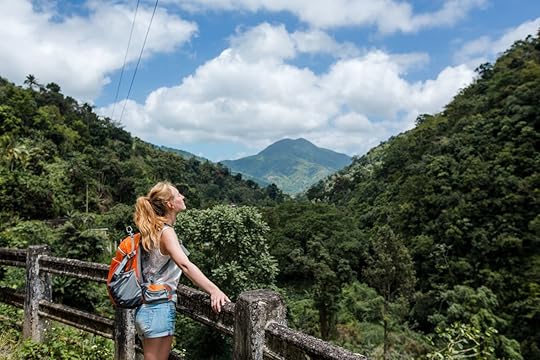
Photo: ajlatan/Shutterstock
Then there are the Blue Mountains, where it’s nearly impossible to avoid social distancing. Head east toward Port Antonio if you like to hike. There are cascades here too, such as Reach Falls in Montane Forest, plus the range’s remote northern foothills nearby. Many of the trails cut through Port Antonio’s prolific banana plantations, including the three- to four-hour Golden Vale route and gentle walk up to the Watch Hill Lookout. Either will impress. 
More like thisTravelThese destinations are opening to US tourists this summer
The post Everything you need to know about visiting Jamaica this summer appeared first on Matador Network.

Ancient shipwreck turned into museum
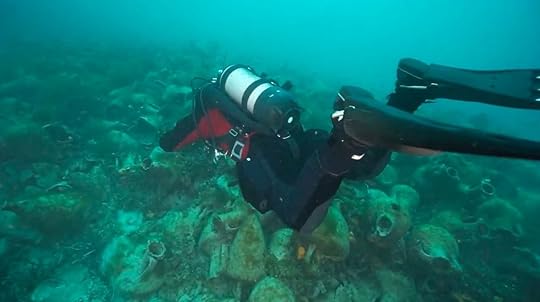
In June, Greece relaxed its rules to allow divers to explore archaeological sites, and starting on August 3, underwater enthusiasts will be able to see one of the most impressive sites in the country.
The Peristera shipwreck laid at the bottom of the Aegean Sea completely undiscovered until the early 1990s. It wasn’t until a fisherman found hundreds of wine jars floating off the coast of Alonissos island did anyone suspect there might be something of significance in the depths. A dive team explored the area and found a massive shipwreck, stretching for 82 feet. It was likely a large merchant ship from Athens, dating back to 500 BCE.
According to the Alonissos Triton Dive Center, “The Peristera shipwreck changed historians’ understanding of shipbuilding in the ancient world. Archaeologists originally thought that this type of shipbuilding originated with the Romans. The Peristera wreck proved that the Greeks were ahead of the Romans [by 400 years].”
The site has been closed to the public since its discovery, but next month it will open as an underwater museum that divers can visit. Starting on August 3, licensed guides will be taking divers from Alonissos to the shipwreck site, where they can go down 92 feet and explore it for themselves.
While the wooden shell of the ship has rotted away, plenty of cargo remains intact, such as 4,000 wine jars that colorful fish and sea sponges call home.
Diving excursions will be available until October 2 of this year, and will reopen again in summer 2021. 
More like thisNewsGreece relaxes rules to allow divers to visit underwater archaeological sites
The post In Greece, a shipwreck from 500 BCE is opening as an underwater museum appeared first on Matador Network.

New overnight train from Prague
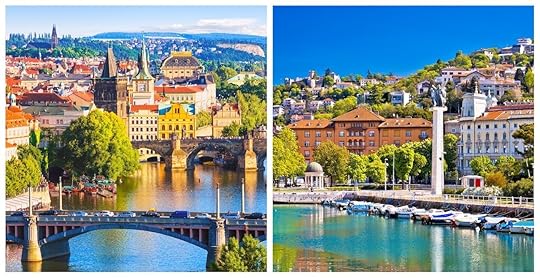
There’s a new way for travelers who want to leave the beauty of the Czech Republic behind to hit the beach this summer. A new overnight train service between Prague and the Croatian coast, operated by the private Czech company RegioJet, launched last month and became an instant phenomenon.
The train was so popular upon its initial launch that RegioJet increased its frequency from three times a week to once per day. It even set a record for ticket sales, selling 4,000 in a single day. The daily schedule will only be in place until late September, however, when the train will return to operating three times a week.
The train leaves Prague every day at 5:20 PM, stopping in Brno and Bratislava in Slovakia before traveling overnight to Ljubljana, Slovenia, and ending at Rijeka, Croatia, at 9:00 AM the next day.
While the train itself will only bring you to Rijeka, the fare also includes bus connections to over 30 locations on the Croatian coast for an additional small fee.
Prices are $25 for a normal seat and $34 for a sleeping compartment. Tickets can be booked online. 
More like thisBeaches + IslandsThe 4 Croatian islands you have to visit this summer
The post This cheap, new overnight train will take you from Prague to the Croatian coast appeared first on Matador Network.

Hawaii postpones reopening

Hawaii has been closed off to domestic travel for months, and currently imposes a 14-day quarantine for all visitors. Governor David Ige had previously announced the state’s intention to reopen to tourism by August 1, but now that date is being pushed back to September 1.
The plan for the August reopening date was for out-of-state visitors to avoid the 14-day quarantine if they tested negative for COVID-19 within 72 hours of their arrival in Hawaii. But with outbreaks on the mainland United States, an increase of cases on Hawaii, and a poor supply of tests to the archipelago, Hawaii is planning to wait before welcoming back tourists.
“This was an extremely difficult decision to make. This delay will further hurt our economy, but as I’ve always said — we will make decisions based on the best available science and facts prioritizing the health and safety of Hawai‘i residents,” said Ige.
The original 14-day quarantine rule was introduced in March and was strictly implemented with expensive fines and even jail time for offenders. 
A version of this article was previously published on June 25, 2020, and was updated on July 14, 2020, with more information.
More like thisOutdoor8 experiences you need to have in Hawaii, no matter what island you visit
The post Hawaii postpones reopening date to September 1 appeared first on Matador Network.

Illustrator unveils life-sized art

French graphic artist Jean Jullien transformed his iconic doodles into life-sized installations for an open-air exhibit at the Jardin des Plantes in Nantes, France. Playfully and organically blending with the garden’s spacious grassland and ponds, the art is part of the annual Le Voyage à Nantes festival that features inspiring outdoor installations. After being slightly delayed by the COVID-19 pandemic, the event will take place between August 8 and September 27 this year.
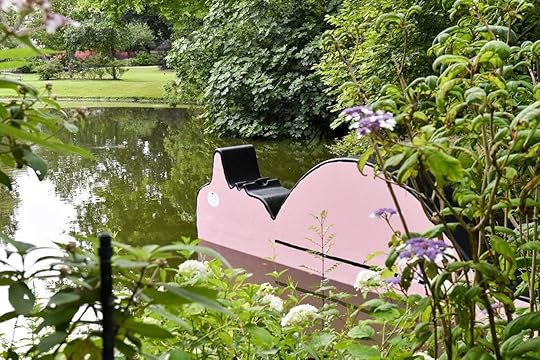
Photo: Jean Jullien
Jullien is known for drawing stick figure characters in a signature black-line style. The installations in the Jardin des Plantes draw on the artist’s techniques and the two-dimensional body shape that he’s known for.
One of the illustrator’s quirky installations in the botanical gardens includes a 26-foot cartoon human seen that’s on their back in one of the garden’s ponds. Another depicts an orange creature walking across a vibrant green field with a huge smile on its face, its long, grass hair trailing elegantly as it marches forward. While three of his installations show solo figures, the fourth and most elaborate portrays three colorful figures embracing the nearby tree trunks in a hug.

Photo: Jean Jullien
“The idea is to have several levels of meaning; something which speaks to the onlookers directly but which then also allows them to stop for a little while and appreciate the surroundings,” Jullien told Dezeen.
The festival is the ideal artistic escape for visitors who’d like to enjoy an outdoor, socially distant exhibit. The garden is open between 8:30 AM and 8:00 PM, and Jullien’s installations are free to enjoy. 
More like thisNewsArtist spreads message of hope with giant grass painting in the Swiss Alps
The post French artist brightens up botanical garden with fantastical creatures appeared first on Matador Network.

Matador Network's Blog
- Matador Network's profile
- 6 followers



